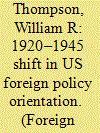|
|
|
Sort Order |
|
|
|
Items / Page
|
|
|
|
|
|
|
| Srl | Item |
| 1 |
ID:
148151


|
|
|
|
|
| Summary/Abstract |
Grand strategy change analyses exhibit problems in balancing the interaction among ideas, external structures and developments, and domestic politics. An alternative theory is constructed that combines the correspondence between external problems and capability, shocks, political entrepreneurship, domestic politics, and reinforcement. The essence of the theory is that strategic shifts are more probable and likely to persist to the extent that more of these components involve significant changes. The 1920–1945 system leader puzzle – why the United States abstained from ascending to the system leader position in 1920 but not in 1945 – is used as an illustration of the theory's explanatory utility.
|
|
|
|
|
|
|
|
|
|
|
|
|
|
|
|
| 2 |
ID:
150572


|
|
|
|
|
| Summary/Abstract |
Historical research on modern Japan has often given insufficient attention to the lives and experiences of children and young people. However, this situation is beginning to change, as historians start to exploit the rich documentary resources, including children’s diaries and letters, that have been collected by institutions across Japan. Japanese children’s responses to disaster and war are especially well documented, and the articles in this special issue begin to explore the potential of these resources. They illuminate different ideals of childhood in Japan during the years between 1920 and 1945, and show how tensions and conflicts between these ideals played out under the stresses of natural disaster and man-made catastrophe. In analysing documents written by children, one crucial methodological and theoretical question is how to assess the degree of agency that such documents show. Adult influences on children’s writing cannot be ignored, and in modern Japan, the education system was arguably the most important channel for such influences. However, we should remember that children also influence one another, and also that the writing of children is, as is of course the case with adults, powerfully shaped by contemporary cultural and social contexts.
|
|
|
|
|
|
|
|
|
|
|
|
|
|
|
|
|
|
|
|
|